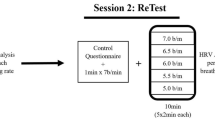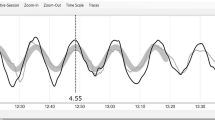Abstract
This study evaluated if an audiovisual (AV) biofeedback causes variation in the level of external and internal correlation due to its interactive intervention in natural breathing. The internal (diaphragm) and external (abdominal wall) respiratory motion signals of 15 healthy human subjects under AV biofeedback and free breathing (FB) were analyzed and measures of correlation and regularity taken. Regularity metrics (root mean square error and spectral power dispersion metric) were obtained and the correlation between these metrics and the internal and external correlation was investigated. For FB and AV biofeedback assisted breathing the mean correlations found between internal and external respiratory motion were 0.96 ± 0.02 and 0.96 ± 0.03, respectively. This means there is no evidence to suggest (p-value = 0.88) any difference in the correlation between internal and external respiratory motion with the use of AV biofeedback. Our results confirmed the hypothesis that the internal–external correlation with AV biofeedback is the same as for free breathing. Should this correlation be maintained for patients, AV biofeedback can be implemented in the clinic with confidence as regularity improvements using AV biofeedback with an external signal will be reflected in increased internal motion regularity.



Similar content being viewed by others
References
Keall PJ, Mageras GS, Balter JM, Emery RS, Forster KM, Jiang SB, Kapatoes JM, Low DA, Murphy MJ, Murray BR (2006) The management of respiratory motion in radiation oncology report of AAPM Task Group 76. Med Phys 33:3874
Vedam S, Kini V, Keall P, Ramakrishnan V, Mostafavi H, Mohan R (2003) Quantifying the predictability of diaphragm motion during respiration with a noninvasive external marker. Med Phys 30:505
Wong JW, Sharpe MB, Jaffray DA, Kini VR, Robertson JM, Stromberg JS, Martinez AA (1999) The use of active breathing control (ABC) to reduce margin for breathing motion. Int J Radiat Oncol* Biol* Phys 44(4):911–919
Marks LB, Bentzen SM, Deasy JO, Kong FMS, Bradley JD, Vogelius IS, El Naqa I, Hubbs JL, Lebesque JV, Timmerman RD (2010) Radiation dose–volume effects in the lung. Int J Radiat Oncol* Biol* Phys 76(3):S70–S76
Kothary N, Heit JJ, Louie JD, Kuo WT, Loo BW, Koong A, Chang DT, Hovsepian D, Sze DY, Hofmann LV (2009) Safety and efficacy of percutaneous fiducial marker implantation for image-guided radiation therapy. J Vasc Interv Radiol 20(2):235–239
Venkat RB, Sawant A, Suh Y, George R, Keall PJ (2008) Development and preliminary evaluation of a prototype audiovisual biofeedback device incorporating a patient-specific guiding waveform. Phys Med Biol 53:N197
George R, Chung TD, Vedam SS, Ramakrishnan V, Mohan R, Weiss E, Keall PJ (2006) Audio–visual biofeedback for respiratory gated radiotherapy: impact of audio instruction and audio–visual biofeedback on respiratory-gated radiotherapy. Int J Radiat Oncol Biol 65(3):924–933
Lu W, Neuner G, George R, Wang Z, Sasor S, Huang X, Regine W, Feigenberg S, D’Souza W (2014) Audio–visual biofeedback does not improve the reliability of target delineation using maximum intensity projection in 4-dimensional computed tomography radiation therapy planning. Int J Radiat Oncol Biol 88(1):229–235
Kim T, Pollock S, Lee D, O’Brien R, Keall P (2012) Audiovisual biofeedback improves diaphragm motion reproducibility in MRI. Med Phys 39:6921
Gierga D, Brewer J, Sharp G, Betke M, Willett C, Chen G (2005) The correlation between internal and external markers for abdominal tumors: implications for respiratory gating. Int J Radiat Oncol Biol 61(5):1551–1558
Mageras G, Yorke E, Rosenzweig K, Braban L, Keatley E, Ford E, Leibel S, Ling C (2001) Fluoroscopic evaluation of diaphragmatic motion reduction with a respiratory gated radiotherapy system. Journal of Applied Clinical Medical Physics 2(4):191–200
Ozhasoglu C, Murphy M (2002) Issues in respiratory motion compensation during external-beam radiotherapy. Int J Radiat Oncol Biol 52(5):1389–1399
Murphy MJ, Dieterich S (2006) Comparative performance of linear and nonlinear neural networks to predict irregular breathing. Phys Med Biol 51(22):5903
Fay MP, Proschan MA (2010) Wilcoxon–Mann–Whitney or t test? On assumptions for hypothesis tests and multiple interpretations of decision rules. Stat Surv 4:1–39
Lim S, Park S, Do Ahn S, Suh Y, Shin S, Lee S-W, Kim J, Choi E, Yi B, Kwon S, Kim S, Jeung T (2007) Guiding curve based on the normal breathing as monitored by thermocouple for regular breathing. Med Phys 34(11):4514
Kini V, Vedam S, Keall P, Patil S, Chen C, Mohan R (2003) Patient training in respiratory-gated radiotherapy. Med Dosim 28(1):7–11
Cho B, Poulsen P, Ruan D, Sawant A, Keall P (2012) Experimental investigation of a general real-time 3D target localization method using sequential kV imaging combined with respiratory motion. Phys Med Biol 57:7395–7407
Cervino LI, Chao AKY, Sandhu A, Jiang SB (2009) The diaphragm as an anatomic surrogate for lung tumor motion. Phys Med Biol 54:3529
Cerviño LI, Jiang Y, Sandhu A, Jiang SB (2010) Tumor motion prediction with the diaphragm as a surrogate: a feasibility study. Phys Med Biol 55:N221
Li R, Lewis JH, Berbeco RI, Xing L (2012) Real-time tumor motion estimation using respiratory surrogate via memory-based learning. Phys Med Biol 57:4771–4786
Ruan D (2010) Kernel density estimation-based real-time prediction for respiratory motion. Phys Med Biol 55:1311
Murphy MJ, Balter J, Balter S, BenComo JA Jr, Das IJ, Jiang SB, Ma CM, Olivera GH, Rodebaugh RF, Ruchala KJ (2007) The management of imaging dose during image-guided radiotherapy: report of the AAPM Task Group 75. Med Phys 34:4041
Hoisak DJ, Sixel K, Tirona R, Cheung P, Pignol JP (2004) Correlation of lung tumor motion with external surrogate indicators of respiration. Radiat Oncol Biol Phys 60(4):1298–1306
Acknowledgments
This work was supported by Sydney Medical School New Staff/Early Career Researcher Scheme grant, NIH/NCI R01CA93626 and an NHMRC Australia Fellowship.
Author information
Authors and Affiliations
Corresponding author
Rights and permissions
About this article
Cite this article
Steel, H., Pollock, S., Lee, D. et al. The internal–external respiratory motion correlation is unaffected by audiovisual biofeedback. Australas Phys Eng Sci Med 37, 97–102 (2014). https://doi.org/10.1007/s13246-014-0247-z
Received:
Accepted:
Published:
Issue Date:
DOI: https://doi.org/10.1007/s13246-014-0247-z




